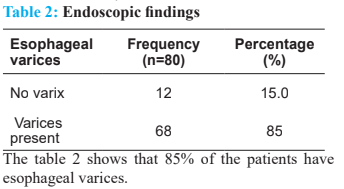Abstract
Background: One of the major causes of morbidity
and mortality in Nepal is portal hypertension due
to liver cirrhosis. In rural areas where a lot of cases
of cirrhosis of liver are prevalent and endoscopic
expertise and facilities are not available, predicting
the presence of esophageal varices through
noninvasive means may reduce a large number of
unnecessary endoscopies. This study is to identify
the relationship of platelet count /splenic bipolar
diameter ratio with the presence of esophageal varices
in portal hypertension.
Materials and methods: Eighty patients were included in this study
between Jestha 2072 to Baisakh 2073 with the
diagnosis of portal hypertension admitted in Bir
hospital,Kathmandu which is a tertiary hospital of
government of Nepal, which were mostly due to
liver cirrhosis. The patients fulfilling the inclusion
criteria underwent lab investigations, ultra sonogram
and UGI endoscopy. The data were assessed for
descriptive studies and means were compared using
t- test. The cut off value of platelet count to spleen
diameter ratio of 1150 was used to predict the
presence or absence of oesophageal varices. Statistical
analysis was done using SPSS 20 software
Results: Platelet count to splenic diameter ratio with a
cut off value of 1150 has sensitivity of 89.7%,
specificity of 83.3%, positive predictive value of
96.8% and negative predictive value of 58.8% (p=
0.002,CI=95%) with 89.5 % accuracy.
Conclusion: Platelet count to splenic bipolar diameter ratio
can be a good predictor of presence of esophageal
varices in patients with portal hypertension
in the resource poor settings.
References
Diodati G, Almasio P, et al. Morbidity and mortality
in compensated cirrhosis type C: a retrospective
follow-up study of 384 patients. Gastroenterology.
1997;112(2):463-72.
2. Gentilini P, Laffi G, La Villa G, Romanelli G,
Buzzelli G, Casini-Raggi V, et al. Long course and
prognostic factors of virus-induced cirrhosis of
the liver. American Journal of Gastroenterology.
1997;92(1).
3. Garrison RN, Cryer HM, Howard DA, Polk
Jr H. Clarification of risk factors for abdominal
operations in patients with hepatic cirrhosis. Annals
of surgery. 1984;199(6):648.
4. Farooqi RJ, Farooqi JI, Ahmad H, Ahmad F,
Gul S. Outcome after injection sclerotherapy for
esophageal variceal bleeding in patients with liver
cirrhosis and COPD. Journal of Postgraduate
Medical Institute (Peshawar-Pakistan). 2011;19(1).
5. Mishra A, Shrestha P, Bista N, Bhurtel P, Bhattarai
S, Thakali K, et al. Pattern of liver diseases. Journal
of Nepal Health Research Council. 2009;7(14):5.
6. Chalasani N, Imperiale TF, Ismail A, Sood G,
Carey M, Wilcox CM, et al. Predictors of large
esophageal varices in patients with cirrhosis.
The American journal of gastroenterology.
1999;94(11):3285-91.
7. Grace ND, Groszmann RJ, Garcia‐Tsao G,
Burroughs AK, Pagliaro L, Makuch RW, et al.
Portal hypertension and variceal bleeding: an
AASLD single topic symposium. Hepatology.
1998;28(3):868-80.
8. D’Amico G, Garcia-Pagan JC, Luca A, Bosch
J. Hepatic vein pressure gradient reduction and
prevention of variceal bleeding in cirrhosis:
a systematic review. Gastroenterology.
2006;131(5):1611-24.
9. Garcia‐Tsao G, Sanyal AJ, Grace ND, Carey W.
Prevention and management of gastroesophageal
varices and variceal hemorrhage in cirrhosis.
Hepatology. 2007;46(3):922-38.
10. Maskey R, Karki P, Ahmed S, Manandhar D.
Clinical profile of patients with cirrhosis of liver in
a tertiary care hospital, Dharan, Nepal. Nepal Med
Coll J. 2011;13(2):115-8.
11. Sarangapani A, Shanmugam C, Kalyanasundaram
M, Rangachari B, Thangavelu P, Subbarayan JK.
Noninvasive prediction of large esophageal varices
in chronic liver disease patients. Saudi Journal of
Gastroenterology. 2010;16(1):38.
12. Prihartini J, Lesmana L, Manan C, Gani RA.
Detection of esophageal varices in liver cirrhosis
using non-invasive parameters. portal. 2005;37(3).
13. Peck-Radosavljevic M. Thrombocytopenia in
liver disease. Canadian journal of gastroenterology=
Journal canadien de gastroenterologie.
2000;14:60D-6D.
14. Giannini E, Botta F, Borro P, Malfatti F,
Fumagalli A, Testa E, et al. Relationship between
thrombopoietin serum levels and liver function
in patients with chronic liver disease related to
hepatitis C virus infection. The American journal of
gastroenterology. 2003;98(11):2516-20.
15. Sallah S, Bobzien W. Bleeding problems in
patients with liver disease: ways to manage the
many hepatic effects on coagulation. Postgraduate
medicine. 1999;106(4):187-95.

